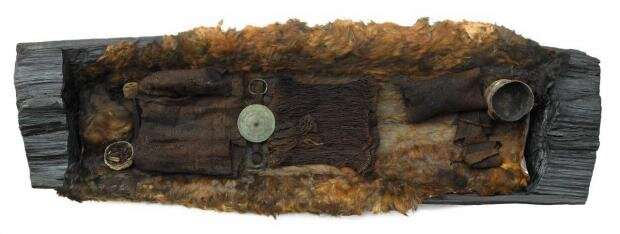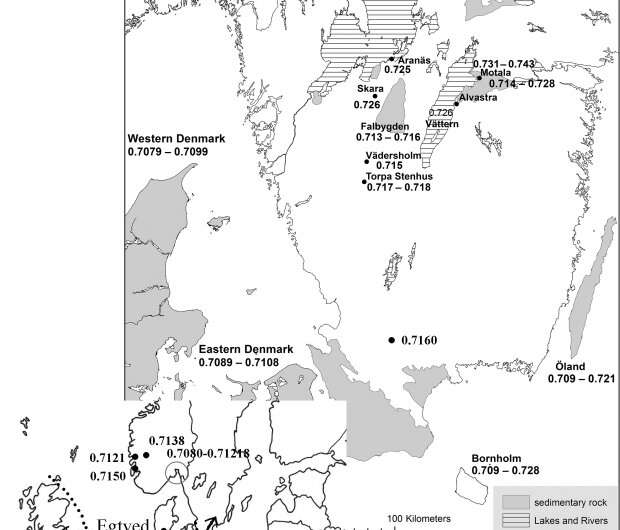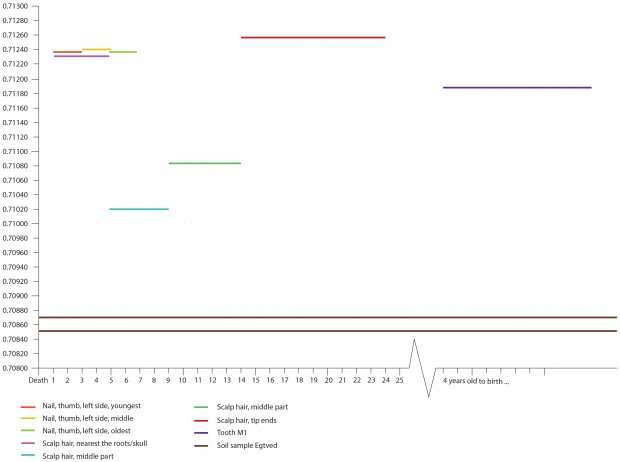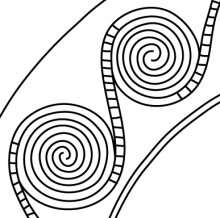The Egtved girl. Photo: Robert Fortuna, National Museum of Denmark. Credit: Reproduced with permission from the National Museum of Denmark
Where was home for The Egtved girl? This question is a hot topic in Bronze Age archaeology right now.
First Karin Frei and her research group conducted innovative strontium analysis (a type of analysis) from which they argued that she most probably came from the Black Forest region (in southwest Germany). This was a groundbreaking discovery, as she was presumed to be of Danish origin until then.
However, based on geological strontium analysis of Danish soils, Erik Thomsen and Rasmus Andreasen recently returned her to her Danish origin as they argued she grew up in the same area where she was found (near Egtved Village, west of Vejle).
Both research groups based their ideas on geology and strontium isotope results, a method that uses strontium isotopes, present in tooth enamel and hair, to identify where an individual was born and/or lived.
In the following, I will argue that neither of the two research groups are right.
Probably from Scandinavia—but not Jutland
My research looked at the strontium isotope results and the archaeological material together and revealed that she was probably Scandinavian, although not from Jutland.
Instead, I show based on the objects she had with her in the grave, that she was probably from the island Bornholm, from south-eastern Sweden or from Rogaland, in southwestern Norway.
Now how can I argue for 3 different locations? The objects she had with her in the grave are not specific to pinpoint one location but they show us these three possible areas that works with the strontium isotope results as well.
"The Egtved girl," who should really be seen as a woman in Bronze Age terms, was between 16 to 18 years old.
In the Bronze Age the average life expectancy was only about 30 years. European studies of Bronze Age graves reveal that females were treated as adults around age 14. The same research show that women were pregnant around 14-15 years of age.
My research has shown that this was the case for Scandinavia, too.
Did she travel from Germany to meet her husband?
Frei and her colleagues base their conclusion on new methods, which mean that we can see the movement of a Bronze Age person from one location to another over time.
They argue that she travelled from South Germany to Denmark to visit her husband-to-be and then back to southern Germany, only to return to Denmark six months later to form a partnership there.
A: Map showing the nearest areas with bioavailable 87Sr/86Sr values that match the strontium isotope values in the Egtved study. (Credit: Redrawn from Frei et al. 2015: fig 1). B: Map showing the published strontium baseline values in Scandinavia. Credit: From Blank submitted, reproduced with permission from M. Blank
In yet another corner, we find Thomsen and Andreasen. They argue that all the strontium values could be local and that the geology in the local area caused the different values.
Strontium isotopes enter our bodies through what we eat and drink. The bedrock the water flows through or the food that grows on top of it produces different values.
This means that we can identify the values present in different regions, which in turn can provide clues about where a prehistoric person lived.
Most scientists involved in strontium isotope studies on archaeological material agree that the water we drink is the biggest contributor to our strontium isotope values.
Thomsen and Andreasen uses only their new baseline for the Vejle area to argue for a local origin. They argue that this area of Denmark has a broader strontium baseline values than the rest of Denmark (except Bornholm). At no point do they use archaeological material or knowledge about the Bronze Age to provide clues about the origin of the Egtved woman.
Did she drink water from the Vejle-area?
The absence of a social explanation for why the Egtved woman was drinking water and eating food from different parts of Vejle area is not explained.
Thomsen and Andreasen appear to have no background knowledge about the Bronze Age, so they have not considered the context. If the woman ate food and drank water from all over the Vejle region and was permanently settled near the mound in Egtved, would the result not have been a mixed non-changing strontium isotope signature instead?
The strontium isotope values in the water we drink and the food we eat are absorbed by the body. If the water and food, as today, comes from many different areas then the strontium isotope values in the enamel or hair would show a value that mixes all these values into one.
In other words, it would not show one of the values but a mixture of them. This mixture would be the same over the years if the food and drink kept coming from the same areas.
In the Bronze Age it makes sense that she would have travelled between different regions rather than that her food has been moved from a large area to her and had come from different region at a non-seasonal pattern.
Archaeology can help us understand
So what does archaeology tell us about the Egtved woman?
Before Frei and her team wrote their article no one doubted a local origin for her, which strengthens Thomsen and Andreasen's interpretation.
However, the Nordic Bronze Age is much bigger than Denmark.
A graph showing the timeline for the different strontium isotope values from the human material. Zero is the time of death. Credit: Made by Richard Potter based on the isotope analysis published in Frei et al. 2015.
Parts of present-day northern Germany, southern Sweden and southern Norway also belonged to this sphere. A large variety of strontium isotope values can be found in the ground in different parts of Scandinavia.
We know that the Egtved woman was dressed in clothing that we typically see as Nordic Bronze Age dress.
To date, the corded skirt she wore has only been found in the Nordic Bronze Age in Scandinavia and in parts of China during the Bronze Age.
Most of the known corded skirts are from eastern Denmark and Scania (southern region of Sweden), though some examples are from southern Norway and Jutland.
Only Egtved's corded skirt is fully preserved, but thanks to the fashion of bronze tubes decorating the cords on the skirts, mainly in eastern Denmark and Scania, we know of more than 40 skirts from this region.
Her skirt came from the area
The strontium isotope value of the corded skirts presented by Frei and colleagues is similar to the value of her tooth and the tooth of the cremated child that was found in a small box next to her. This may mean that her corded skirt was made in her home area. It also strengthens the idea of a Nordic Bronze Age origin.
The Egtved woman was buried with a belt-plate, two arm-rings, a small ring found close to the head, an awl and a comb.
The two arm-rings are commonly found all over Europe and so do not give information about where she came from. The same can be said about the awl.
The small ring found near the head is unusual in Scandinavia, and could point to a link to somewhere else in Europe. Small rings placed near the head are common in many parts of Central Europe and therefore do not prove an origin in the Black Forest.
There are few or no traces of Bronze Age houses or burials in the Black Forest region. The area seems not to have been populated in the period, which makes it unlikely she came from that region.
A connection with the Nordic Bronze Age region is illustrated by the belt-plate and the comb. Both objects are commonly found in Scandinavian burials. Can they also help to show whether she originated in the Vejle region or somewhere else in the Nordic region?
The combs are not helping
The combs are found on Jutland, Zealand, and Scania. Most of the horn combs are found on Jutland, but this is due to the outstanding preservation of the mounds in this region. The comb does not help us answer the question of where in Scandinavia she was born.
Belt-plates are generally more commonly found in eastern Denmark and southern Sweden than in southern Denmark. They are rarely found in southern Denmark.
A part of the belt-plate, showing the ornamentation. Credit: Drawing made by Richard Potter
The Egtved woman's belt-plate has a special spiral pattern (see figure) which otherwise is only found in other spiral decoration known from south-eastern Sweden and Rogaland, Norway.
In these areas one can find strontium isotope values that correlate with her tooth (childhood) and some of the values from samples of hair.
Thomsen and Andreasen's idea of her being from the Vejle-area needs to be challenged because strontium isotope values cannot prove local origin.
The method can only show if someone previously lived in another location. Prehistoric individuals with a local baseline can be from many areas as the same strontium isotope values can be found in many areas. It is up to geologists to discuss whether or not all of Egtved's strontium isotope values could be local.
Archaeologically, it makes no sense that a woman buried in the centre of a mound, a woman who had status and prestige, would have moved around within the local area, living just a short time at different households in the region.
This pattern of movement would have fit a lower status person who needed to move to find work.
Remains a mystery
Exactly who the Egtved woman was remains a mystery. She seems to have had few relations (if any) within the Vejle area.
Maybe she was a respected specialist of some kind who travelled with her work? The sheets of heather and wool cord with oxtail hair that accompanied her may indicate that she was a skilled healer, or it could be evidence that she was ill before she died.
In the Bronze Age context it is more likely that she actually travelled between regions and made longer stops during her journeys.
Taking a combined view of the evidence, the Black Forest is unlikely to have been her home, while there are persuasive reasons to suggest an origin in the Nordic Bronze Age.
New methods and natural scientific analysis have brought new information to archaeology but the interpretation of these discoveries always needs to be combined with archaeological knowledge.
The numbers themselves give us no answers; they must be seen alongside archaeological data and knowledge in order to make sense.
Further studies into the movement patterns of Bronze Age peoples might help us understand why the Egtved woman received the honour of being placed under a mound in the Vejle area when she died so soon after arriving to the area.
More information: Karin Margarita Frei et al. Tracing the dynamic life story of a Bronze Age Female, Scientific Reports (2015). DOI: 10.1038/srep10431
Erik Thomsen et al. Agricultural lime disturbs natural strontium isotope variations: Implications for provenance and migration studies, Science Advances (2019). DOI: 10.1126/sciadv.aav8083
Katharina Rebay-Salisbury et al. Motherhood at Early Bronze Age Unterhautzenthal, Lower Austria, Archaeologia Austriaca (2018). DOI: 10.1553/archaeologia102s71
www.gu.se/english/about_the_un … 100001&userId=xbeiso
Journal information: Science Advances , Scientific Reports
Provided by ScienceNordic
This story is republished courtesy of ScienceNordic, the trusted source for English-language science news from the Nordic countries. Read the original story here.



























